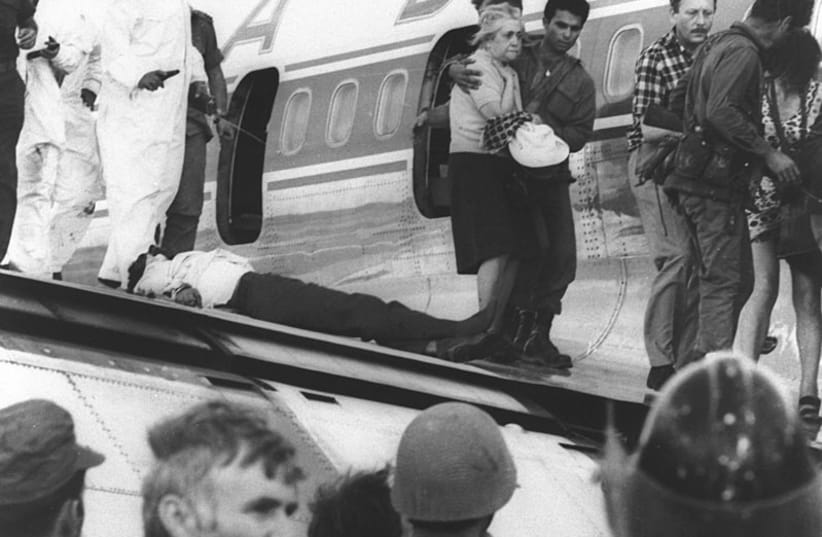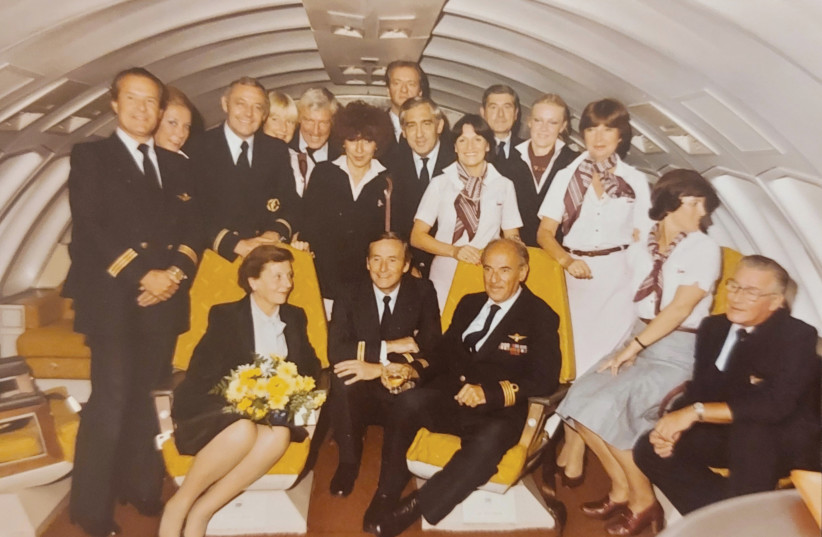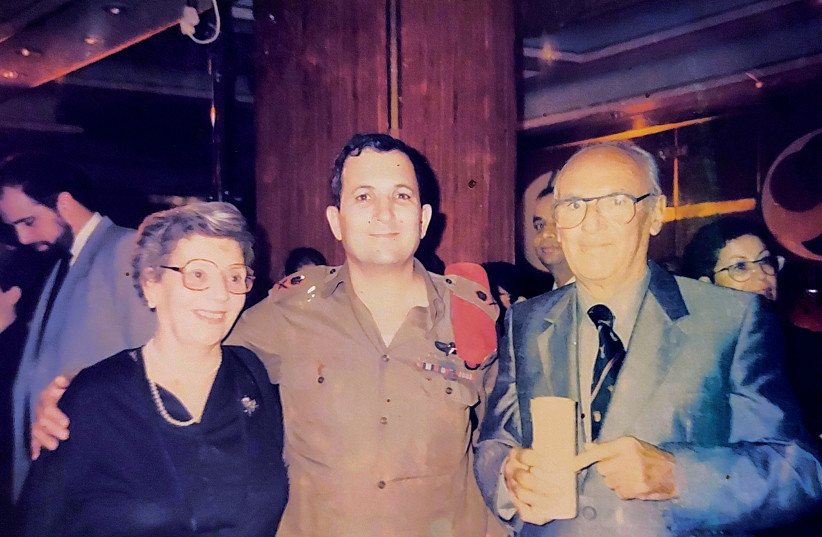A day before the Black September Organization’s hijacking of Sabena Flight 571 from Brussels via Vienna to Lod on May 8, 1972, Capt. Reginald Levy called his daughter, Linda, who worked as a flight attendant for British Caledonian at the time. He told her that he was flying to Tel Aviv with her mother, Dora, on his 50th birthday and had booked a table “at a lovely restaurant near the Dan Hotel” to celebrate.
After Levy’s family heard about the hijack, they gathered in their Brussels home – Linda, 26, her 15-year-old sister and her two brothers, the older one with his wife and their three-year-old daughter. “It really turned our lives upside down,” Linda recalls. “We knew nothing about Israel and the Palestinian conflict. I remember going to the local shop to get the papers and was shocked that life was going on as normal. I kept thinking: Don’t they know what we’re going through?”
Twenty minutes after takeoff from Vienna, two male terrorists armed with pistols and grenades broke into the cockpit, while their comrades – two women carrying plastic explosives – remained in the cabin. Levy managed to relay a message to Israel requesting help and after landing conveyed the hijackers’ demand to Israeli officials for a Palestinian prisoner release.
“We weren’t worried about dad because we knew he could handle it,” Linda says. “He was a professional who flew in the RAF. But, we were all worried about mum. They had been on the plane for over 24 hours and it must have been so hard for her.”
A day later, in what was dubbed Operation Isotope, a team of 16 Sayeret Matkal commandos led by Ehud Barak – including Benjamin Netanyahu and Danny Yatom – approached the plane disguised as mechanics in white overalls, stormed it and within minutes shot dead the two male hijackers, captured the two female hijackers and rescued the 90 passengers. A pregnant passenger wounded in the exchange of fire later died of her injuries.
“Then we got a phone call from Reuters and the journalist said, ‘We’ve just had news that your father is safe. The plane has been released. And I said, ‘What about my mum?’ And he said, ‘I’ll get back to you.’ He called a few minutes later to say that mum was safe also.”
Another Sabena pilot, Jack Ellis, took the family out for dinner that night to celebrate. “Then at 8:30 the next morning, the phone rang and it was dad. He said, ‘I don’t know when we’re coming back. They have to repair the plane, but mum wants you four kids to be there when we get back. I said, ‘We’re all here in your house, waiting for you.’ I asked what happened. And he said, ‘I’ll talk to you when I get back.’”
A couple days later, the family were driven to a hangar at the airport in Brussels. “The plane seemed so enormous close up. Dad was there waving out the cockpit window and then all the crew got off the plane. Only after they were all on the ground, my mother appeared at the top of the steps with a huge bunch of flowers. The four of us just burst into tears seeing her.”
Following the rescue of the hostages, Capt. Levy was hailed as a hero by Israel but blamed by the PLO for aiding the Israelis, and the family was sent first to Spain and then to South Africa by Sabena to protect them. “Because of apartheid, South Africa had no relations with Arab countries, and my dad would just fly the Johannesburg-Brussels route,” Linda says. “The PLO threatened Sabena that if my dad ever flew again, they would blow up the plane. They said it was because of my dad that their operation wasn’t successful.”
When the Lipschitz family from Johannesburg made aliyah, the Levy family rented their home. Linda later joined them, met the son they left behind, Stanley, and when her parents returned to Belgium, she flew with him to what was now called Ben-Gurion Airport in 1974. “I fell in love with Israel the first time I set foot in the country,” she says. “Although my father was Jewish, I converted to Judaism, married Stanley, had two children – and now have five grandchildren.”
After initially working for the Anti-Defamation League, Linda became a founding member of The Jerusalem Report established by Hirsh Goodman in 1990. “One of our covers featured Ehud Barak on the wing of Sabena with some hostages,” she says. “We had a young intern from Canada working with us who saw it and said, ‘That’s my grandmother!’ I was blown away!”
Several years after the hijacking, Reginald and Dora Levy were invited to the Dan Hotel in Tel Aviv to a festive event marking 40 years of Sabena operating in Israel. The night before, Dora told Linda that although it was nice meeting dignitaries, her dream was to meet the baby-faced soldier who reassured her so calmly when she was lying on the floor of the plane that “everything’s gonna be alright.”
At the gala dinner, Gen. Barak entered the room and greeted Capt. Levy. When Dora saw him, she let go of Linda’s arm, exclaimed “It’s him!” and threw her arms around Barak. Linda recalls: “He said, ‘Yes, it’s me. The last time I saw you you were lying on the floor!’ She was so happy.”
They were later invited by media personality Dan Shilon to appear on his television show, where they were again reunited with Barak and most of the commando crew members who rescued the hostages. Among others, they also met and befriended Golda Meir, who had been prime minister at the time, Moshe Dayan, who was defense minister, and Shimon Peres, who was transportation minister at the time of the hijacking.
Five years after Capt. Levy died in 2010 at the age of 88, his grandson Alex Schiphorst published his memoir, From Night Flak to Hijack. He relates the dramatic moment of the hijacking in a transcript:
At about 14:35 GMT, this would be somewhere around Sarajevo, I heard a scream from the back, from round about the cockpit door. I looked round and saw one of our hostesses on the floor and this terrorist coming into the cockpit, shaking like a leaf, with a pistol and a grenade in his hand, and he thrust the pistol into my neck and said, “Keep calm, keep calm. Follow our orders, we are taking over this aircraft.”
Reginald and Dora Levy came to Israel on numerous occasions to visit Linda and her family. A passenger on the hijacked plane, Rafi Bar-Am, wrote him a heartfelt letter of thanks for his bravery, coolness and grace under pressure.
Linda was contacted by producers who made a film and a documentary about the hijack and by countless journalists over the years. “When my dad died, his obituary was the most read article in The New York Times,” she says. “The story was published everywhere.”
Asked why she thinks the story of the hijacking resonates with so many people, she says, “It’s such a part of Israeli history. The rescue operation was so dramatic and amazing. Israel had a plan from the start. The Israeli commandos executed their jobs so well. We have this amazing army who know what they’re doing and I really feel safe here in Israel. As for my dad, he said, ‘I don’t know what the fuss was all about. I was only doing my job.’ He somehow persuaded the hijackers to let him go over to the terminal to talk to the Israelis. Before he left, they gave him a piece of the plastic explosive to show that they meant business in their threat to blow up the plane.”
Capt. Levy handed over the piece of plastic explosive, which was sent to be tested. “It turned out to be Semtex, which was the same material used to blow up Pan Am’s Lockerbie flight,” Linda says. “When I was working for ADL, I took some visiting police chiefs from the US to a meeting with Prof. Yossi Almog, and he told them that Israel was the first country to have a sample of Semtex from the captain of the Sabena plane on the ninth of May. And I said, ‘Excuse me, Yossi, but it was the eighth of May. The captain was my dad.”
Asked what she feels 50 years later, Linda Lipschitz says: “It’s something that’s with you all the time, and every year there’s something that takes you back. Thirty-five years later, when I was working for The Jerusalem Post, I got a phone call from someone named Eliezer Sacks who said he had found my dad’s pilot hat.
“During the hijacking, one of the hijackers took the hat off my dad and said, ‘Call me the captain now. Captain Rifat.’ He wore my dad’s hat during the whole operation. My mum recalled that when she got off the plane, she stepped over the body of the hijacker, and the hat was next to him, covered in blood.
“Eliezer was in the Golani unit that cleaned up the plane after the operation,” Linda says. “He said, ‘Your dad came up to us with the hat and put it on someone and said this was for you as a thank you.’ For many years, no one knew where it was, but then a member of the unit was cleaning out his house and found it, with my dad’s initials, RL, and blood stains. He came to The Jerusalem Post and gave it to me, and it’s now hanging in my home in Jerusalem.”


